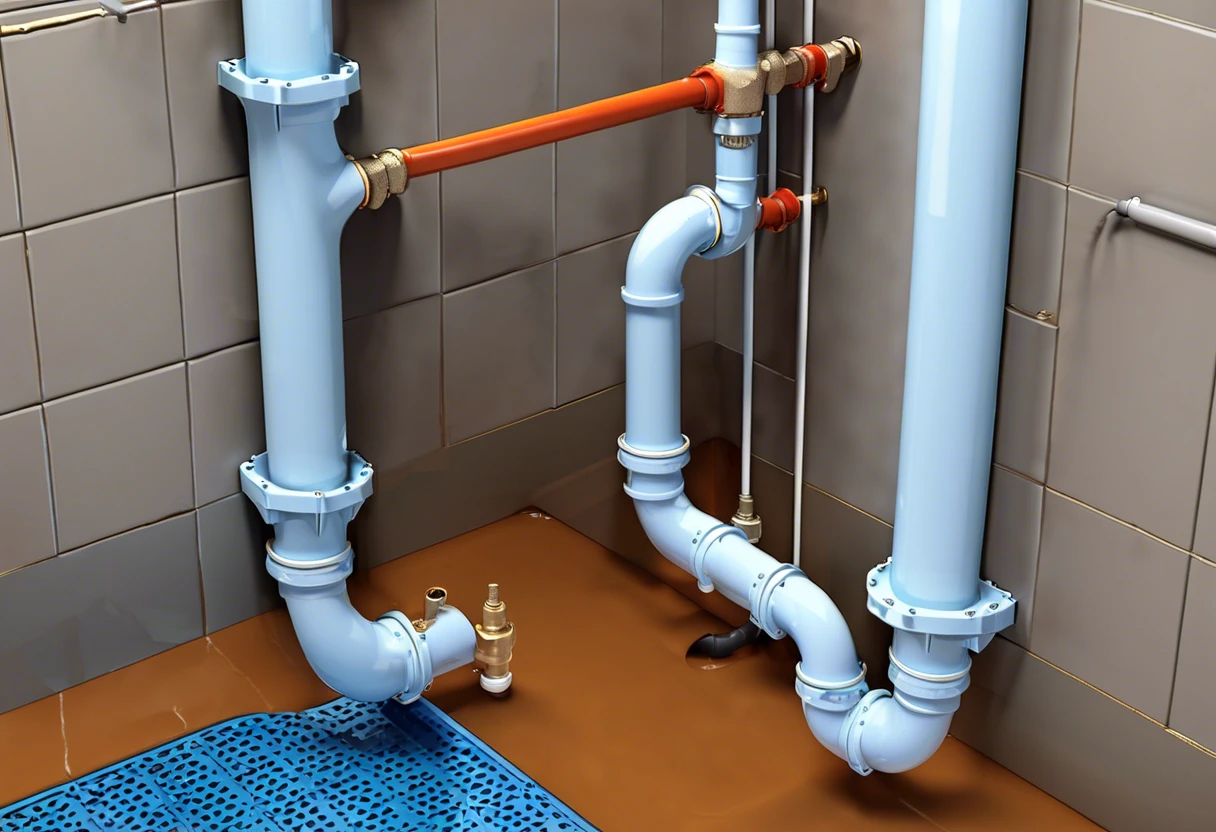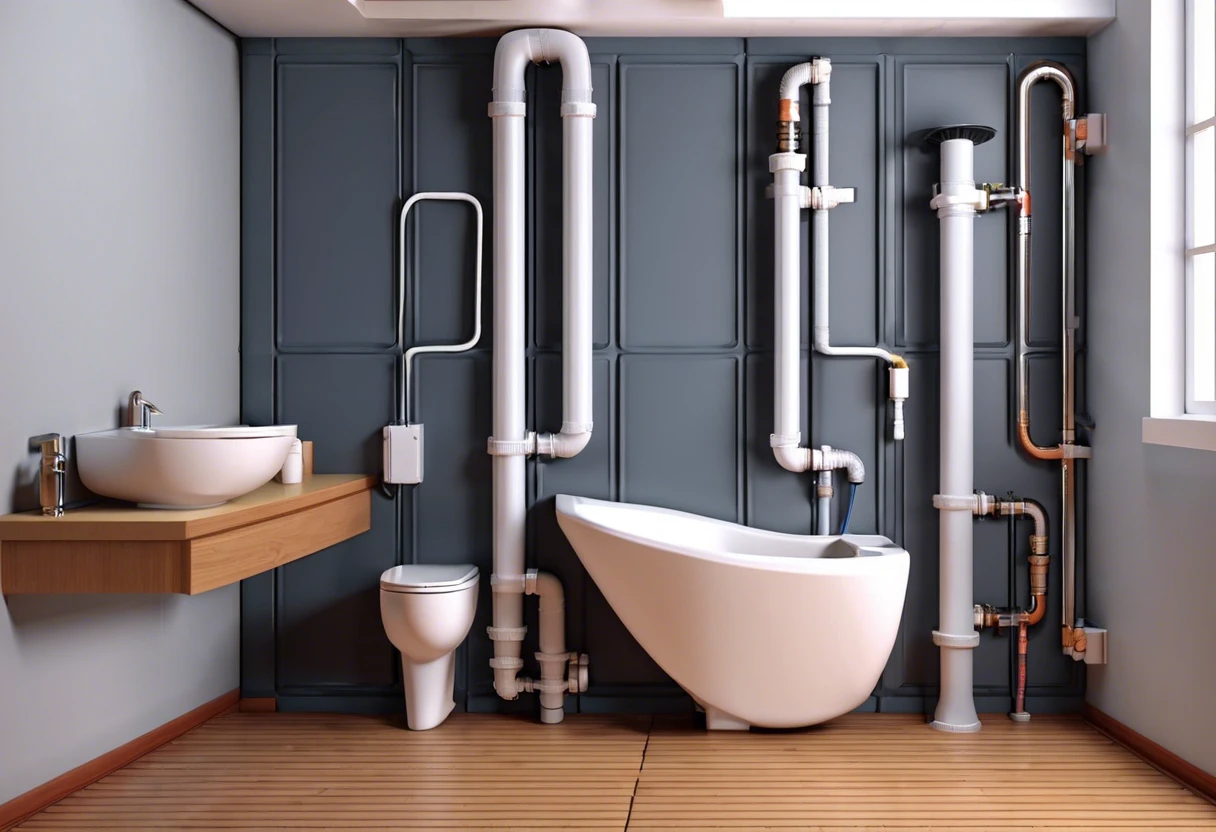How Thick Are Plumbing Walls? Understanding Sizes, Costs, and When to Seek Help
Published on: March 23, 2025 | Last Updated: March 23, 2025
Written By: anaheimplumbers
So, you’re wondering how thick plumbing walls really are? You’re in the right spot! Whether you’re looking to tackle a DIY project or you’re simply curious about what’s behind those walls, knowing the implications of plumbing wall thickness is essential for your home and budget.
I totally understand your curiosity. Having navigated the intricacies of plumbing wall thickness right here in Anaheim Hills, I can provide valuable insights without overwhelming you. With my experience in various plumbing jobs, let’s dive into this topic together.
In this guide, we’ll explore the details of plumbing wall thickness, including standard measurements, cost implications, and when to consult a professional. You’ll also find answers to common questions about plumbing wall thickness that I’ve frequently encountered in my years of service.
Page Contents
- 1 How Thick Are Plumbing Walls?
- 2 Key Takeaways About Plumbing Wall Thickness
- 3 Understanding Plumbing Wall Thickness and Related Information
- 4 Additional Factors Influencing Plumbing Wall Thickness
- 5 In-depth Look at Plumbing Wall Thickness Measurements
- 6 Cost Implications of Plumbing Wall Thickness
- 7 When to Consult Professionals for Plumbing Wall Thickness Issues
- 8 Frequently Asked Questions About Plumbing Wall Thickness
- 9 Final Thoughts on Plumbing Wall Thickness and Its Importance
- 10 Useful References for You:
How Thick Are Plumbing Walls?
The thickness of plumbing walls can vary, typically ranging from 1/2 to 3/4 inches. However, various factors, including insulation requirements and local building codes, influence these measurements. Always check local regulations for specific requirements that may apply to your situation!
Key Takeaways About Plumbing Wall Thickness
- Understanding wall thickness helps recognize plumbing installation standards.
- Knowledge of measurements ensures informed decisions for remodeling or repairs.
- Plumbing costs can vary based on wall thickness, significantly impacting your budget.
- Consulting professionals regarding plumbing wall thickness can save both time and money.
Understanding Plumbing Wall Thickness and Related Information
So, how thick are plumbing walls, particularly in residential areas like Anaheim Hills? Generally, plumbing walls have a thickness of about 4 to 6 inches (100 to 150 mm). This thickness allows sufficient room for piping, insulation, and other plumbing components, creating an efficient design.
Typical Plumbing Wall Thickness Standards
In residential setups, plumbing walls typically measure between 2 to 4 inches in thickness (5 to 10 cm). If you’re using 2×4 framing, expect approximately 3.5 inches (8.9 cm) of thickness between the frames. These common standards are crucial for proper plumbing system functionality.
Materials That Impact Wall Thickness
The materials used for plumbing walls significantly influence their overall thickness and, consequently, project costs. Common options include drywall, studs, and sometimes brick or concrete block. Each of these materials has specific thickness measurements that can impact your budget. When clients in OC seek cost-effective solutions, I often recommend lighter materials that offer excellent durability—a consideration that becomes even more relevant during our fire season. Additionally, an essential factor to contemplate when planning your plumbing system is the presence of a house trap. This crucial component plays a significant role in ensuring proper drainage. To gain a deeper understanding of what a house trap is and how it functions, you can explore this detailed explanation.
Variations According to Building Codes
In Anaheim, building codes dictate standard plumbing wall thickness, prioritizing both safety and aesthetic considerations. For areas with higher plumbing demands, such as bathrooms or laundry rooms, a minimum thickness of 6 inches (150 mm) is often required. These regulations not only ensure proper installation but also help reduce maintenance concerns in the long run. If you’re contemplating starting your own plumbing venture, understanding the associated costs is crucial. To gain insights into how much it costs to start a plumbing business in Anaheim Hills, take a moment to explore this important financial aspect.
As you consider how thick plumbing walls are, it’s important to take into account various factors that may affect your choices, such as existing plumbing systems and the necessary levels of insulation. Additionally, understanding the functionality of plumbing in apartment settings can significantly enhance your decision-making process. For instance, during a recent project in Serrano Heights, we had to dismantle and modify an existing plumbing wall; the adjustments in thickness led to a remarkable improvement in the home’s energy efficiency. To explore how plumbing operates in different environments, you can learn more about it by checking out how plumbing works in an apartment building.
Considering the weight of fixtures and pipes is also essential. If you’re planning to install a heavy bathroom shower unit against an exterior wall, ensuring that the wall meets code and offers adequate thickness is vital. This was particularly relevant in a renovation I oversaw last fall, where we reinforced walls to accommodate new plumbing requirements while ensuring the overall integrity of the structure.
Ultimately, designing rustic, charming homes in OC encompasses more than aesthetics; it’s about precision in plumbing specifications. The thickness of plumbing walls plays a crucial role in the overall infrastructure of your home, so give these elements the attention they deserve!
You should now have a solid understanding of plumbing wall thickness and its implications. Next, we’ll address additional factors that influence these measurements.
Also See: What is MIP Plumbing? A Simple Guide for Homeowners

Additional Factors Influencing Plumbing Wall Thickness
Many elements can influence how thick your plumbing walls need to be, each playing a significant role in plumbing system efficiency and safety.
Environmental Conditions in Anaheim Hills
Living in Anaheim Hills, residents experience unique weather conditions that can significantly impact plumbing installations. The region’s warm summers and occasional rainy spells make it essential to consider these factors when planning for insulation needs. If you’re contemplating a plumbing career in this area, it’s important to understand that obtaining a plumbing license is a crucial step. To learn more about the specific requirements for licensure, you can explore this guide on Anaheim Hills plumbing blog.
- High temperatures necessitate appropriate insulation thickness to prevent pipe expansion.
- Increased humidity may require thicker walls to support vapor barriers, particularly in areas like laundry rooms.
Types of Plumbing Systems and Their Requirements
The requirements of your plumbing system can also influence wall thickness. Here are some common plumbing systems found in many homes:
- Drainage systems generally need thicker walls to accommodate pipe sizes and potential blockages.
- Hot water systems often need optimized insulation thickness for energy efficiency.
Access Panels and Their Impact on Wall Thickness
Sometimes, homeowners require access panels to reach pipelines, which can necessitate specific thickness considerations:
- Access panels may require additional framing, which can slightly increase wall thickness.
- The placement of access panels should account for the overall wall thickness for maximum efficiency.
Table: Impact of Various Factors on Plumbing Wall Thickness
| Factors | Impact on Thickness | Recommended Action |
|---|---|---|
| Environmental Conditions | Increased insulation needs | Consult local codes for climate-specific thickness |
| Plumbing System Type | Varies by design requirements | Consider thicker frameworks for drainage systems |
| Access Panel Installations | Potentially increases overall wall thickness | Incorporate in remodeling plans early |
We’ve covered various factors affecting plumbing wall thickness. Now, let’s examine detailed plumbing wall thickness measurements.
In-depth Look at Plumbing Wall Thickness Measurements
Here, I’ll share insights on plumbing wall thickness measurements, highlighting both American and metric units for your convenience.
Plumbing Wall Thickness Measurements in Inches
- In residential settings, plumbing walls typically range from 2 to 4 inches in thickness (5 to 10 cm).
- For standard applications, 2×4 framing offers around 3.5 inches (8.9 cm) of wall space.
Plumbing Wall Thickness in Millimeters
- This thickness translates to approximately 50mm to 100mm for typical plumbing wall setups.
- A standard frame involves nearly 89mm width, which is suitable for most applications.
Understanding Plumbing Wall Thickness for Residential Structures
- Residential plumbing codes often specify wall depths to accommodate pipes, which can vary based on local standards.
- I’ve witnessed instances where inadequate thickness resulted in structural issues; proper planning must not be overlooked!
Insights From DIY Communities
- Browsing forums like Reddit, many DIYers recommend a measurement of 2-3 inches for standard projects.
- These discussions often include tales of unexpected leaks resulting from thinner wall setups!
How Thick Are Plumbing Walls in Feet?
- If you’re measuring in feet, plumbing walls typically range from about 0.16 ft to 0.33 ft.
Bathroom Wall Thickness Measurements
- Bathrooms often require slightly thicker walls—usually around 76mm (about 3 inches) to ensure effective plumbing.
- I recall a remodeling project where focusing on proper thickness led to significantly enhanced plumbing functionality!
Wall Thickness for Shower Plumbing Systems
- Shower plumbing usually needs up to 100mm for effective drainage to prevent leaks.
- Pro tip: Utilize thicker materials in shower installations, especially where high water pressure or humidity is expected!
How Thick Are Interior Walls Compared to Plumbing Walls?
- Typically, interior walls measure around 4.5 inches (11.4 cm), including room for drywall. Pipes are usually located within that space.
- This can lead to confusion about room sizing—the slightest discrepancy may cause issues down the line!
We have now discussed plumbing wall thickness measurements and their importance. Next, let’s look at the cost implications related to plumbing wall thickness.
Cost Implications of Plumbing Wall Thickness
When budgeting for plumbing wall thickness, anticipate costs ranging from $1 to $5 per linear foot, which can vary depending on the materials chosen. However, it’s important to account for unforeseen expenses that may arise, such as local permits or labor costs, which can elevate your initial estimate. To ensure adequate coverage, I recommend adding approximately 20% more to your original budget. Additionally, as you plan your finances, consider the overall expenses related to plumbing installation. For a clearer understanding of those costs, take a moment to explore how much new plumbing costs.
Based on my experiences in homes around Anaheim Hills, a complete plumbing overhaul typically requires about 1 to 3 weeks to complete. For example, I recently assisted a family, the Gilberts, with their plumbing renovations, which incurred a cost of approximately $4,000. This expense aligns with the historical trends observed during peak fire seasons in the area. If you’re considering launching a plumbing or electrical service, understanding the local regulations is crucial. To get started, you can explore essential information about owning a plumbing business in Anaheim Hills.
Cost Breakdown of Plumbing Wall Thickness
| Materials | Low Estimate ($) | High Estimate ($) |
|---|---|---|
| PVC Pipes | 1 | 3 |
| CPVC Pipes | 1.50 | 4 |
| Copper Pipes | 2 | 5 |
| Installation Costs | 50 | 150 |
| Permits & Fees | 100 | 300 |
Having examined how plumbing wall thickness affects budget costs, let’s now discuss when it’s prudent to consult professionals regarding these matters.

When to Consult Professionals for Plumbing Wall Thickness Issues
At some point, you may encounter plumbing wall thickness issues that require professional assistance. When seeking help, prioritize experts who not only grasp the complexities of plumbing but also have a strong reputation within the community. On the other hand, if you’re contemplating tackling plumbing on your own, you might wonder just how challenging it really is to master the basics. To get a clearer understanding, you can check if plumbing is hard to learn before diving into the project.
Through my experiences assisting homeowners, I’ve discovered that signs of wear or visible cracks in plumbing walls often indicate the need for professional guidance. Navigating complex codes and essential repairs on your own can lead to future complications and added stress. It’s vital to avoid using outdated or damaged pipes, as this can result in costly repairs later on. To better understand which plumbing pipes may be problematic, I recommend exploring this useful resource, which provides valuable information to help you identify potential issues.
Benefits Of Hiring a Local Anaheim Hills Plumbing Expert
Engaging a local plumbing expert offers the benefit of their extensive knowledge of regional standards and plumbing systems. For example, I once completed a historic home renovation in Anaheim Hills, where adhering to strict local regulations was crucial. Local contractors from Anaheim Hills Plumbers helped me connect with suitable materials and methods to effectively address the aged plumbing walls.
Ensuring that your renovations adhere to local plumbing codes is crucial, particularly when addressing the important issue of how thick plumbing walls are. Compliance is essential for maintaining safety in your Anaheim Hills home. Additionally, before undertaking any excavation work, it’s necessary to obtain the proper permit. To navigate this process effectively, it’s important to familiarize yourself with the requirements for obtaining a plumbing permit for excavation in Anaheim Hills. By getting a plumbing permit, you can safeguard yourself against potential legal issues and ensure that your project aligns with local regulations.
Frequently Asked Questions About Plumbing Wall Thickness
Below are some common inquiries regarding plumbing wall thickness, which may shed further light on your concerns.
Should Plumbing Walls Be 2×6?
Yes, plumbing walls can and often should be framed as 2×6, particularly when additional space for pipes and insulation is required. This choice generally enhances water supply lines and can circumvent plumbing issues in the long term.
Can You Fit Plumbing in a 2×4 Wall?
Yes, plumbing can indeed be fitted within a 2×4 wall; however, this requires careful planning and may restrict options for insulation or future upgrades. When working with 2×4 configurations, efficiently routing or stacking pipes is essential to ensure functionality and maximize space. If you’re aiming to enhance your plumbing setup, understanding how to plumb a power beyond valve is crucial for implementing systems that integrate seamlessly with your existing infrastructure. For comprehensive guidance on this topic, you can find more information here.
What is the Thickness of Pipe Walls?
The thickness of pipe walls can vary depending on the type of pipe, but for residential plumbing, standard wall thicknesses typically range from 0.065 inches to 0.375 inches. Understanding these dimensions is essential for selecting the right fittings and mounting options. Furthermore, when it comes to using plumbing glue, the drying time can significantly impact your project’s timeline. To gain insight into this important factor, you can explore detailed information on plumbing glue drying times.
Are There Standard Measurements for Construction Plumbing Walls?
Yes, standard measurements for construction plumbing walls typically adhere to guidelines associated with wood framing, such as the commonly used 2×4 or 2×6 sizes. Grasping these measurements is essential for establishing proper plumbing setups during various construction phases. Additionally, being informed about the number of phases that plumbing projects undergo can significantly enhance your planning and ensure that every step is executed correctly throughout the process. For a deeper understanding of plumbing systems and their components, it’s important to consider how each phase contributes to the overall project.
What Wall Thickness is Ideal for Water Supply Plumbing?
An ideal wall thickness for water supply plumbing ranges from 4.5 inches (2×4) to 5.5 inches (2×6). Choosing the correct wall thickness is vital for ensuring the efficiency and reliability of your plumbing systems.
Final Thoughts on Plumbing Wall Thickness and Its Importance
In summary, we covered key details about how thick plumbing walls are, understanding plumbing wall thickness, relevant measurements, budgeting impacts, and when to consult professionals.
In conclusion, plumbing walls typically range from 1/2 to 6 inches thick, ensuring the efficiency and reliability of your plumbing systems. For any assistance, feel free to visit Anaheim Hills Plumbers for a quick quote estimate and access to professional plumbing services.
Useful References for You:
- Anaheim Public Utilities (Water Services and Regulations)
- How thick is a plumbing wall? Plumbing furring wall depth. – DK Inc.
- Plumbing Wall and Chase Dimensions | UpCodes
- r/Plumbing on Reddit: Plumbing Wall Thickness?
- Estimating final wall thickness using Kerdi – Ceramic Tile Advice Forums – John Bridge Ceramic Tile

